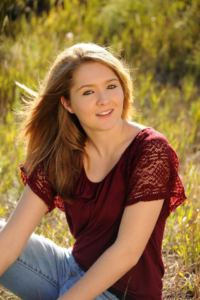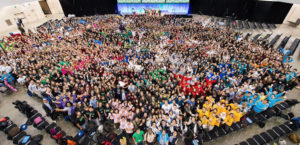 Renée Plomondon has learned a lot from her undergraduate research: how to collaborate with researchers from around the world, how to be modify genes, and how to make bacteria implode.
Renée Plomondon has learned a lot from her undergraduate research: how to collaborate with researchers from around the world, how to be modify genes, and how to make bacteria implode.
Plomondon is a fifth-year biochemistry undergrad at Colorado State University and has conducted a variety of research in different labs. In her first year, she studied human biomechanics using an iPhone’s gyroscope in CSU’s Clinical Biomechanics Laboratory, led by Raoul Reiser, an associate professor in the Department of Health and Exercise Science. As a second-year student, she studied cancer cells in the Prasad Lab for Ashok Prasad, an assistant professor in the Department of Chemical and Biological Engineering. This experience allowed her to learn about cellular processes by directly observing them, and it was one of her favorite experiences at CSU.
“You’re like, oh my gosh, this all makes sense when you actually do it yourself,” she said.
Now Plomondon is working with Paul Laybourn, a professor in the Biochemistry and Molecular Biology Department, to research better ways to teach biology. Her experience in research has helped shape her trajectory at CSU – and what she hopes to do after graduation this fall.
Hacking germs
During her second year, Plomondon joined CSU’s Synthetic Biology Club, which is sponsored by the International Genetically Engineered Machine Foundation (iGem). The club is a student-led undergraduate research program currently advised by Claudia Gentry-Weeks, an associate professor in the Department of Microbiology, Immunology and Pathology, Christie Peebles, an associate professor in the Department of Chemical and Biological Engineering, and Tom Santangelo, an associate professor in the Department of Biochemistry and Molecular Biology.
As part of the club, Plomondon worked on a student research team to develop a version of E. coli that converted used cooking oil into a valuable plant hormone. Her role was to make a “kill switch” by inserting pieces of new genes into the bacterium to make it implode if it left its food source. Implanting new genes in E. coli’s DNA is a technique she learned in a cell biology lab class.
“You can basically cut out pieces and put new ones in so you can make them glow green, you can make them explode,” she said. “You can do a lot of really cool stuff.”
Plomondon and the rest of the team presented their work at the 2014 iGem Giant Jamboree, an international competition for synthetic biology students. The team won a silver medal at the event and Plomondon enjoyed sharing her knowledge with student researchers from around the world.
“With everybody talking and collaborating, it felt like this beautiful scientific flow,” she said.
CSU’s 2015 iGem Team presented a similar project and won a silver medal at that year’s competition.
Research results
After she graduates in December, Plomondon hopes to pursue a career in genetic counseling, an up-and-coming field where she will advise people on their genetics and hereditary diseases. She was prompted to explore the career by her lab experience at CSU – which also looks fantastic on a resume, she said.
For undergrads who want to get involved in research, Plomondon recommended reaching out to a professor whose work sounds interesting. She said that students should also read some of that professor’s publications and prepare relevant questions to ask them.
“These steps show a professor that you are serious about their research,” she said.
Many professors are especially interested in taking on first-year students because they have four years to dive into a project.
“They want new, fresh brains and someone to just absorb everything that the professor has done their whole life’s research on,” Plomondon said.
Another avenue to gain undergraduate research experience is CSU’s Synthetic Biology Club, she suggested. Alternately, students can ask their advisor about research opportunities or visit the College of Natural Science’s undergraduate research page.
Plomondon said that no matter how they do it, undergrads should get involved in research at CSU.
“Undergrad research isn’t a huge thing in other colleges, and CSU is very unique for that,” she said. “I love that CSU can put so much emphasis on research.”
